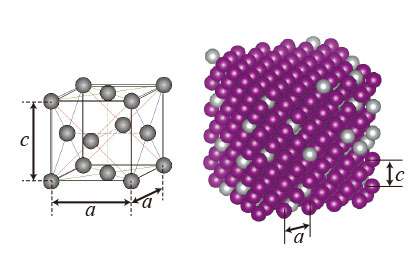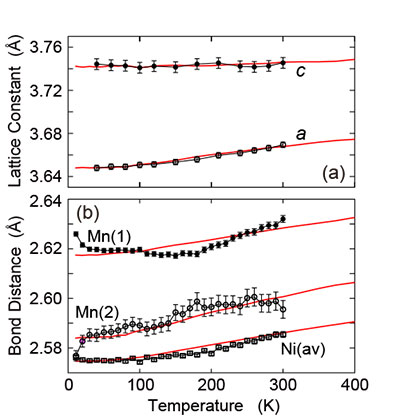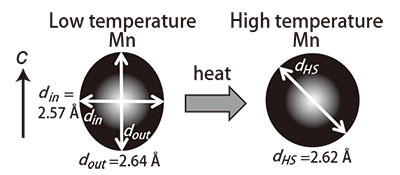Toshihiko Yokoyama (Department of Materials Science, IMS) and his collaborator Keitaro Eguchi (Department of Structural Molecular Science, Sokendai) has revealed the origin of the cooperative Invar/anti-Invar effects observed in a MnNi alloy by means of x-ray absorption fine structure spectroscopy measurements using synchrotron radiation and path integral computational simulations.
Since the discovery of Invar alloy Fe64.6Ni35.4 by C. E. Guillaume in 1897 [1] that shows anomalously small thermal expansion for the wide temperature range from extremely low to high temperatures, the origin of the Invar effect has been a long-standing problem. The present team previously clarified that the weakness of thermal expansion of the Invar alloy at very low temperature originates from the vibrational quantum effect [2]. In the present study, the team has subsequently investigated thermal expansion of a tetragonal Mn88Ni12 alloy, whose structures are depicted in Fig. 1, by x-ray diffraction (XRD), Mn and Ni K-edge extended x-ray-absorption fine-structure (EXAFS) spectroscopy, and the computational simulations based on the path-integral effective-classical-potential theory. It is elucidated from the XRD given in Fig. 2(a) that the tetragonal lattice constant c exhibits almost no thermal expansion like an Invar alloy, while the lattice constant a shows even larger thermal expansion than usually expected from anharmonicity, implying significant anisotropy in thermal expansion. The EXAFS analysis in Fig. 2(b) reveals that the Mn local environment is actually tetragonally distorted, while the Ni one retains its inherent cubic-like symmetry. Combined with the computational simulations, it is concluded that large thermal expansion along the a axis originates from the anti-Invar effect, while negligibly small thermal expansion along the c axis does from the cooperative Invar effect. Namely, as shown in Fig. 3, the tetragonally distorted more stable antiferromagnetic Mn state gives a significantly smaller (slightly longer) atomic radius along the a (c) axis than the radius of the spherical paramagnetic state.

Fig. 1: Typical crystal structure of a random MnNi alloy with the atomic ratio of Mn:Ni=88:12 (right panel). The left panel corresponds to one tetragonal unit cell, where Mn and Ni atoms locate at the apices and the center of the faces. The lattice constant c is slightly larger than a.

Fig. 2: Temperature dependence of (a) the lattice constants a (open circles with error bars) and c (filled circles with error bars), and (b) the nearest neighbor bond distances around Mn (open and filled circles with error bars) and Ni (open squares with error bars), together with the simulated results (red lines). The lattice constant c shows almost no thermal expansion (Invar effect), while a exhibits larger expansion than usually expected (anti-Invar effect). There were separately observed two kinds of bonds around Mn, consistent with the fact of the tetragonal lattice, while Ni shows apparently one type of bonds behaving as a cubic lattice. There exist however many kinds of the bonds around Ni with various lengths of the distances.

Fig. 3: Mn atom in Mn88Ni12. Mn is a spheroid at low temperature, with a longer axis parallel to the crystalline c axis. With a temperature rise, the concentration of spherical Mn increases, resulting in a larger thermal expansion along a axis and a weak expansion along c axis.
References
[1] C. E. Guillaume, CR Acad. Sci. 125, 235 (1897).
[2] T. Yokoyama and K. Eguchi, Phys. Rev. Lett. 107, 065901 (2011); T. Yokoyama, e-J. Surf. Sci. Nanotech., 10, 486 (2012).
[3] A. Cuccoli, R. Giachetti, V. Tognetti, R. Vaia, and P. Verrucchi, J. Phys.: Condens. Matter 7, 7891 (1995); T. Yokoyama, Phys. Rev. B 57, 3423 (1998).
1113



